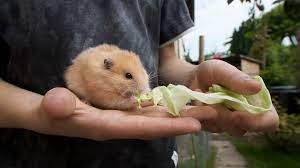Can Hamsters Eat Cabbage?
Quick Navigation
Yes, hamsters can eat cabbage. Whether it is a Syrian, Russian dwarf, or Chinese hamster, cabbage is a strongly recommended diet for all hamsters’ breeds because of its nutritional benefits. They love this crunchy vegetable.
Precautions to Take When Giving Your Hamsters Cabbage
Clean the cabbage before giving it to your pet. It will wash away the preservatives that might be harmful to them. Also, feed the cabbage to the hamsters in small pieces; this will prevent them from getting choked.
How Many Times Can I Feed My Hamsters Cabbage Weekly?
It is recommended not to feed hamsters cabbage more than three times a week. Also, a half to full teaspoon of cabbage is enough every time you serve your hamster’s cabbage.
How to Feed Hamsters Cabbage
if the hamster suffers from intestinal problems, it is better not to give them. If the hamster is healthy, there is no problem. Never give large doses: better small doses and always together with other vegetables. Cut the cabbage into smaller pieces (size of a fingernail), and feed it to the hamsters. If the cabbage is kept in the fridge for two days before feeding them, it becomes more digestible because the cold transforms the non-digestible parts into more digestible sugars. Do not give the outer leaves. Give the hamster the pieces of cauliflower we eat, not the scraps!. By eating cabbage, hamsters can give off unpleasant odors, and their urine can smell. But it is harmless.
Read also is celery good for hamsters? is it recommended?
What Food, Fruits, and Vegetables Can Hamsters Eat?
Many households have raised cute little hamsters, but hamsters will die after eating food harmful to them. What foods, fruits, and vegetables can hamsters eat? According to a hamster lover report, hamsters cannot eat oil and salty foods consumed by humans. Tap water, rainwater, and spring water are also bad for hamsters. It will cause hamster diarrhea (often called the wet tail), which is fatal to hamsters. So, the best drinking water for them is cold water.
Hamsters can eat fresh vegetables and fruits cut into small pieces. They can be provided as a staple food. Broccoli and apples are recommended. Whole grains and bread crumbs are also ok (do not dip the sauce, just the white part of the bread). Dried fruits of melon seeds can also be fed, but they cannot be used as a staple food. They can only eat a little bit as a snack in a day. If you feed them too much, hamsters will get angry, their eyes will protrude, and symptoms such as lumps will appear on their body.
You might also be interested in is broccoli good for hamsters? is it recommended?
How To Introduce New Foods in the Hamster’s Diet?
Newly introduced foods should be given to the hamsters little by little to avoid problems with the hamster’s stomach or cause diarrhea.
An excellent way to introduce these foods is to give a portion of fruit or vegetable between the interval of two days.
Once his system gets used to it, you can start feeding him that food more often. Do not give the same thing repeatedly. It is better to intersperse fruit, vegetables, and other foods.
It is necessary to clean the fruits and vegetables thoroughly before feeding them to hamsters. For healthiness, avoid feeding your pets cold food. If there is one thing you must be sure of, it is that there are no fungicides in fruits and vegetables. If you are not sure, it is best to avoid wild plants, vegetables, and fruits.
Always keep fresh water and food in their cage to feed them whenever they need it. Try to avoid giving them commercial food most times and incorporate fresh fruit, vegetables, and some meat into their diet.
How To Know a Healthy Hamster?
1. Choose a hamster that has bright eyes and no excrement.
2. Check if the hamster has a runny nose, don’t pick it if it does.
3. Examine whether the shape of the ear is intact and whether there are any traces of it being bitten. If there are, it means that the hamster is too weak or sick and was bitten by other hamsters.
4. Monitor whether the teeth are not stretched out and the hair color is shiny. Check for hair loss or tumors.
5. There should be no urine stains on the buttocks, as this is a sign of ill health.
6. Check whether the nose is bitten, red, swollen, or even bleeding. If it is, it means that the hamster is not healthy and robust enough to be bullied by other hamsters.
7. Choose a vigorous and energetic hamster. The sluggish, mentally weak mice must be sick.
8. The hamster’s nose should be pink and tender, the ears should be the same size, the eyes should be watery, and the hair on the back should not be bitten. You can also observe whether the hamster runs around vigorously. This indicates that it has a healthy body and doesn’t get sick often.
Conclusion
To keep our hamster in perfect condition, it is essential to provide a varied diet, high fiber, and a low-fat index. Keep in mind that these small rodents tend to obesity if we measure neither the amount of food nor the products we offer; that’s why we need to pay close attention to their diet and follow the best diet for them. Cabbage is a good treat for hamsters, but its excess can be harmful to them.
Read more onis cheese good for hamsters? is it recommended?‘

